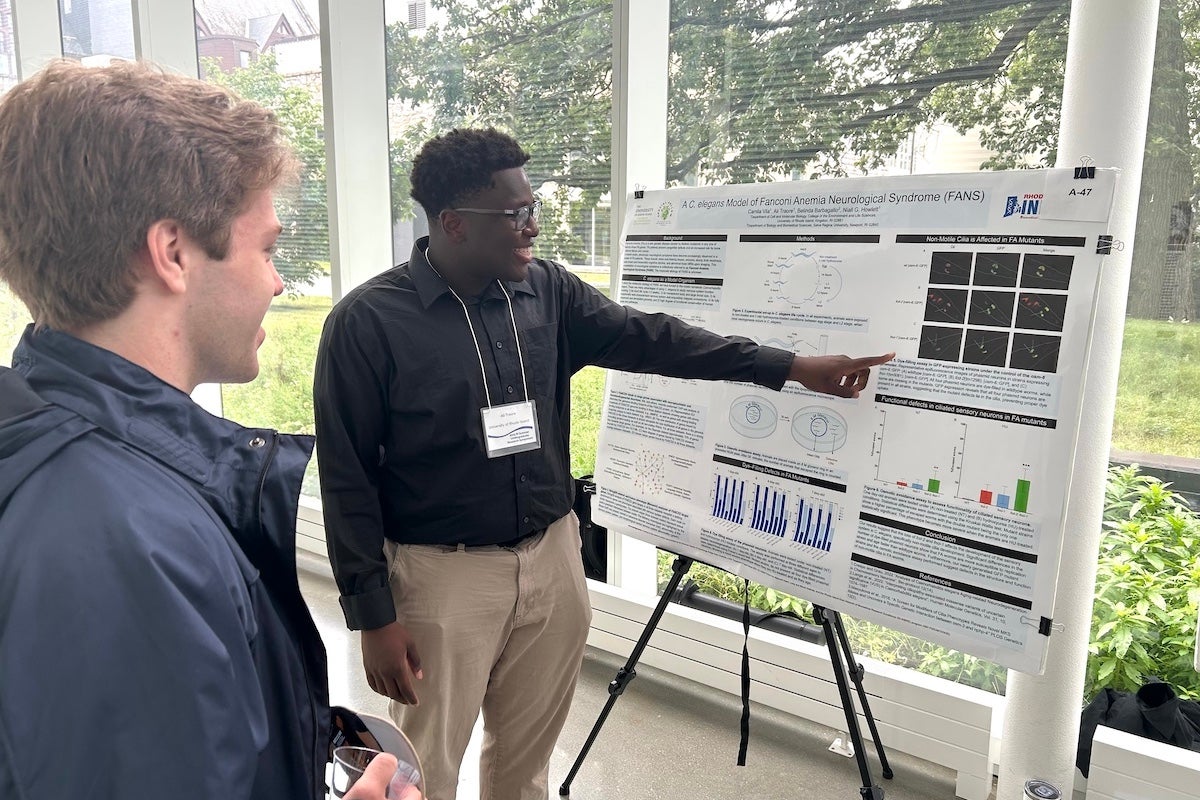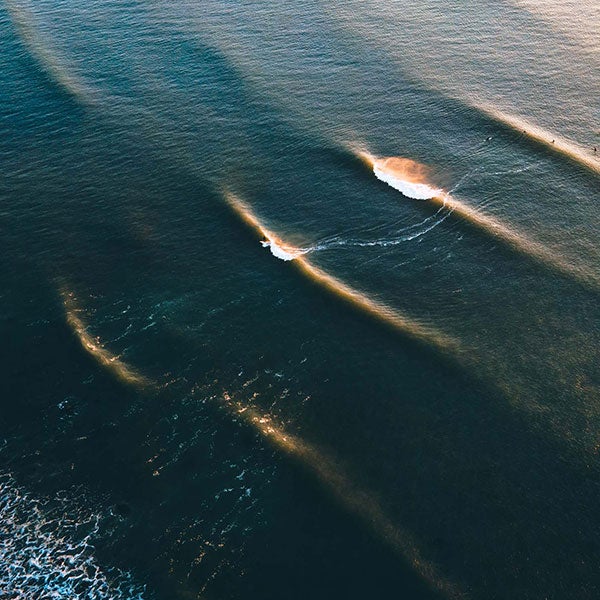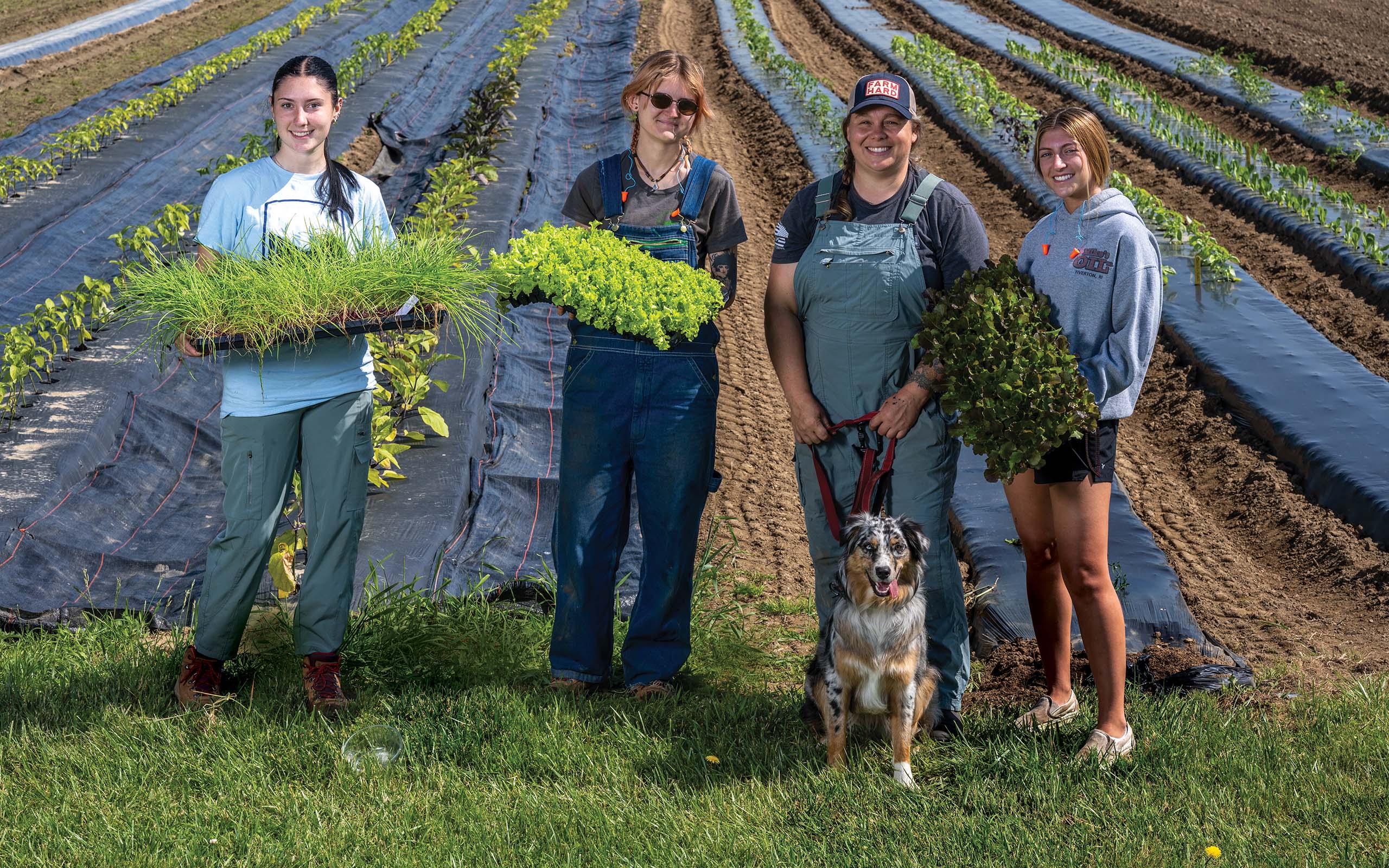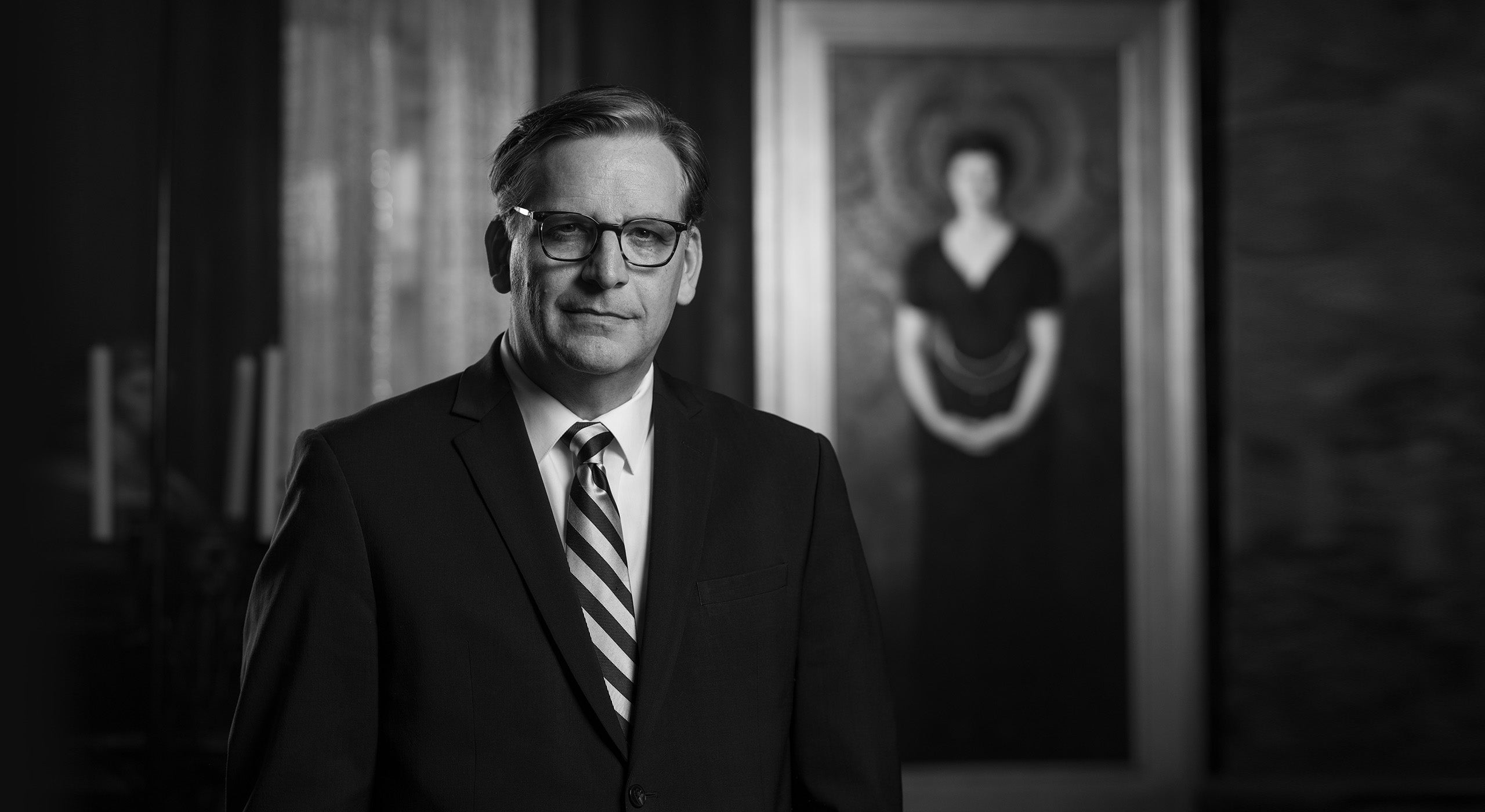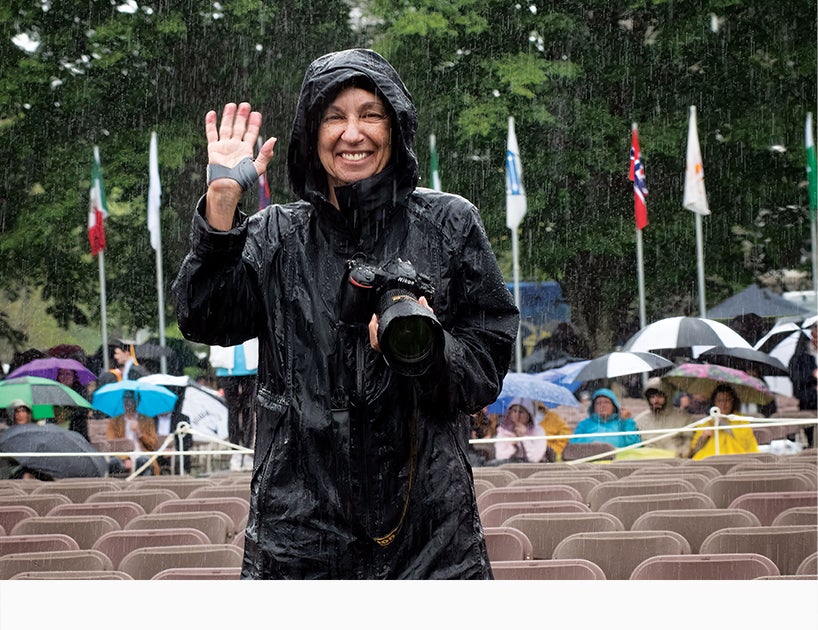More Than Hoops – An American Story
Filmmaker Evan Villari ’02 and storyteller Len Cabral at the Herbert L. Swenson Jr. Court on Smith Street in North Providence, R.I.
Go to providenceinnercityarts.org for more on the Meet Me at the Court project.
Filmmaker Evan Villari ’02 and renowned Rhode Island storyteller Len Cabral are producing a documentary film, Meet Me at the Court. The film will tell the story of the legendary North Providence Summer Basketball League and the players who competed on the Herbert L. Swenson Jr. Court on Smith Street, including many URI players and nearly three dozen players who made it to the NBA.
By Bob Herzog
Just a half-mile from where Evan Villari ’02 grew up, in the Fruit Hill section of North Providence, R.I., local basketball history was being made.
Throughout the 1980s and early ’90s, the filmmaker and college professor didn’t realize what the hoopla was all about. But as an adult, he recognized the significance of what was happening on his hometown court. So, for Villari, a basketball fan who loves telling stories, a film project about the saga of the North Providence Summer Basketball League (NPSBL) was irresistible.
“This story is exciting because it’s not only about a high level of play on a small basketball court in a small town in a small state,” Villari says, “but it also reflects the social dynamics of this country from 1962 through 1994.”
That’s no small matter. The asphalt on the courts at the Ernie DiGregorio Sports Complex on Smith Street served as a court of public opinion for a generation of voices. “I can remember passing by the park as a kid and seeing the lights and hearing the crowd cheer. I thought of it as the ‘big kids’ league.’ You would see lines of cars all the way through the neighborhood,” Villari, 44, says. “There were bleachers, and then people started bringing lawn chairs and blankets. They huddled around the playground area, the concession stand, and the tennis courts that bordered the main attraction. Hundreds and hundreds of people showed up because they knew that this was the place to be.”
That outdoor court on Smith Street was the place to play hoops, watch hoops, and talk about hoops. “The North Providence Summer Basketball League was one of the earliest to integrate players of color, offering a safe space where, if you could play, you could stay,” Villari says, noting that 1962 was a turbulent time in American history as far as civil rights and race relations were concerned. “It didn’t matter your background. It didn’t matter what school you went to, who your parents were, or what you looked like. It didn’t matter your size; it didn’t matter your age. If you could play, that was it. And it just kept going and going for 32 years.”
The league folded when Villari was 13, long before he could even consider trying to play in it. That’s why he didn’t fully grasp its status when he was a kid. But when he learned about the origins and the long-running narrative of the NPSBL about two years ago, he was inspired to tell this American story, set in his backyard.
Villari is an independent filmmaker and founding director of the Center for Media Production at Johnson & Wales University, where he is a professor of filmmaking. He studied communications and film at URI, where his professors included filmmakers Sheri Wills and Mary Healey Jamiel.
Growing up, one of Villari’s heroes was award-winning master storyteller and fellow North Providence native, Len Cabral. Cabral is known for his dynamic storytelling of traditional folktales from around the world, including Cape Verde, Africa, and the Caribbean.
Two years ago, Cabral, who is artistic director for the the nonprofit Providence Inner City Arts was looking for a filmmaker to tell a different kind of story. That’s when he and Villari connected and decided to work together to produce Meet Me at the Court, a documentary on the history of the North Providence Summer Basketball League.


Len Cabral and Evan Villari ’02 in Villari’s home studio.
When that court was in session, URI notables who played on it included Percy Davis ’79, Claude English ’72, Tom Garrick ’90, Kenny Green ’89, and Mike Fascitelli ’78, Hon. ’08. Providence College stars David Turbridy, Ernie DiGregorio, Marvin Barnes, Joe Hassett, Mike Riordan, Otis Thorpe, and Kevin Stacom also played there, along with John Bagley and Jamie Benton from Boston College—Benton was a four-time NPSBL MVP.
In Villari’s office, which includes both vintage and state-of-the-art movie-making equipment, a Meet Me at the Court poster hangs on a bulletin board. The poster was a gift to Villari from a student and not an actual promotional poster, and Villari says its attention-grabbing “Coming Spring 2026” headline may be a bit optimistic. He laments a familiar obstacle for many independent filmmakers: the need for solid financial backing. “The project is in the works and filming has begun,” he says. “But we are also, simultaneously, into fundraising.”
The team includes Villari as writer, producer, and director, Antonio Lopes as producer, and Len Cabral, along with his brother, Ali Cabral, as executive producers. Renowned hip-hop artist Duval “Masta Ace” Clear ’88 permitted the team to use his track, “Born to Roll,” in their proof-of-concept sizzle reel.
Courts and leagues that give rise to college and professional stars and become part of a city’s summer soul are not a new theme. Harlem’s Rucker League and the pickup games at the Venice Beach courts in Los Angeles are legendary, and there are other talent-rich courts from coast-to-coast.
The NPSBL never was at that level, Villari says, “just because of the size of the state. I think it’s better that it’s from a small town. That makes it a better story than if it were New York or L.A.”
Len Cabral, 77, calls the film a coming-of-age story. “It’s a group of teenagers, 15 to maybe 18 years old, who wanted to hang out, play basketball, and stay out of trouble. No helicopter parents around all the time. Then it just snowballs from there,” he says.
“Len’s brother, Ali Cabral, who was one of the original 10 boys who founded the league in 1962 at the height of the Civil Rights Movement, is central to the film,” says Villari. “According to Ali, he is the only one of the surviving founders who was there at the Town Hall in 1962.”
In 1962, Ali Cabral and his friends successfully petitioned the North Providence Town Council for use of the court and for the installation of lights. They dressed up to attend Town Council meetings, and they went door to door, soliciting sponsors and signatures for their petition. Their persistence was rewarded. Local grocery stores, pubs, barbershops, and other businesses sponsored the teams and supplied T-shirts, which the teenagers proudly wore around the neighborhood, not just on game nights.

Ali Cabral, president of Providence Inner City Arts and brother of storyteller Len Cabral, was a founding member of the North Providence Summer Basketball League.
“Len’s brother, Ali Cabral, who was one of the orginal 10 boys who founded the league in 1962 at the height of the Civil Rights Movement, is central to the film.”
—Evan Villari ’02
As the league grew in stature, it attracted college coaches. A familiar figure at these games was then-Providence College coach Joe Mullaney and later, Dave Gavitt, who coached at Providence College from 1969–79 and was later the driving force behind the formation of the Big East Conference, which changed the face of college basketball. Basketball fever was breaking out all over New England in the 1960s because of the success of Bill Russell and the perennial NBA champion Boston Celtics. The NPSBL began drawing teams from the Boston area to compete against Rhode Island’s finest.
One of the league’s central figures was Tom Cannon, who served as league commissioner from 1975–1994 and was responsible for getting and maintaining NCAA sanctioning, which helped the league attract top college players and coaches during its prime years.
“A lot of these guys went to college on scholarships because they were seen by the coaches,” Cabral says. “It was getting toward the end of the ’60s—Vietnam, civil rights, a whole lot of social stuff was happening in America at the time. But this was a place where people could get out and just play ball. People from all walks of life, from different communities, would be there. This was the court that had the lights, this was the court that had the reputation, and this was the court where you’d see the best ballplayers.”

Len Cabral and Evan Villari ’02 on the North Providence court that is the setting for their documentary, Meet Me at the Court.
It was originally called Evans Court, but when a local teenager, Herbie Swenson, drowned, the court was renamed Swenson Court. Three years later, another local teenager, Chuckie Ruggerio, died tragically, and in the early 2000s, a second court was named for him.
“For us boys, who were 14, 15, 16 years old, it was the first time a friend of ours had died,” Cabral says. “Usually, it was somebody’s grandparent who died. So, the name of the court had meaning for us.”So did the league. For three decades, it featured what Cabral calls “the cream of the crop in Southern New England basketball.”
One of the most decorated and well-known NPSBL alumni is Tom Garrick, a star for the Rams from 1984–88, who played in the NBA for four seasons and professionally in Europe for another six. He didn’t play in the NPSBL until he got to college.
“I was just a kid from West Warwick, and you didn’t just get a chance to play in the league unless you had some credentials,” Garrick says in a phone interview from Nashville, where he is the assistant women’s basketball coach at Vanderbilt University. His wife, former University of Connecticut star Shea Ralph, is the head coach. “It was college players, former college players, high-level local guys. There were a lot of summer leagues in Rhode Island, but the best one was the North Providence summer league, and not everybody could play in it. It wasn’t a guarantee.”
After his first year at URI, Garrick got his NPSBL invitation from Cannon, who recruited much of the talent and whose wife kept the scorebooks. Garrick partnered in the backcourt with his friend, Jamie Benton, who was a high school star at Providence’s La Salle Academy, played for four years at Boston College, and just completed his 25th season as the men’s basketball coach at Johnson & Wales University. Garrick, 59, says he loved the NPSBL so much that he continued playing throughout his pro career, which ended after the 1998 season when he played in the Turkish pro league.
“Just the idea of being a Rhode Island kid and playing in that league—and having success in that league—and playing with my friends, it was a great chapter in my basketball life. Guys still talk about those days years later,” says Garrick, who remembers winning multiple NPSBL championships.


Villari has collected volumes of newspaper clippings, photos, and score sheets, including these: A score sheet and a 1977 clipping from The Observer which shows Vic Soares, who played at URI from 1974–1977, in action on the court in North Providence, and a photo of the NPSBL 1992 championship team, LSB. URI’s Tom Garrick ’90 is pictured, third from left, holding trophy.
Villari can verify what Garrick remembers because, in his deep dive into the league’s history, he has collected scorebooks from many games and compiled detailed scrapbooks with photos, programs, and newspaper accounts. When prompted, he can turn to a carefully laminated page with photos of Garrick and Benton in action.
This was no leisurely summer league, and Garrick and Benton led their team, LSB (sponsored by Larry Sciarra Building Co.), to league titles in 1985, 1987–88, and 1990–92.
“You didn’t want to get embarrassed because there were a lot of fans there who came to see good basketball,” Garrick says, revealing some of his renowned competitiveness. “Once I got to the NBA, I changed. I was a pro, and I wasn’t going to lose in summer ball. Then, when I played overseas, I just wasn’t going to come back to Rhode Island and lose in the North Providence Summer Basketball League after playing pro ball in Turkey.”
That’s why Garrick often stuck around to scout his next opponent when his games were over. He saw some familiar faces. “The fans were consistent. You’d see the same people in the stands twice a week. New people would come in, but there were always the older gentlemen who would sit on the end line in their lawn chairs,” Garrick says. “They didn’t bother with the stands, where people might be there just to watch their team. These old guys were there all night. You started to know them; they started to know you. It was really a fun atmosphere to be part of something like that.”
That was also true for Mike Fascitelli, who played in the NPSBL about a decade before Garrick and remembers watching Providence College legends Barnes and DiGregorio play.
Fascitelli, 68, was not a star on the summer league court. But off the court, few NPSBL alumni can match his résumé. He graduated summa cum laude from URI with a B.S. in industrial engineering and earned his M.B.A. from Harvard in 1982. He started his working life as an engineer, but switched his focus to business, and his career took off. He was a partner, president, and CEO of major investment firms, was involved in the acquisition of several major office buildings, including Madison Square Garden, and today serves on the executive boards of numerous large companies.
Basketball remains a driving force in his life. Since 2014, Fascitelli has been part owner of the Milwaukee Bucks, who won the 2021 NBA championship. He says he’ll always cherish the memory of having his sons with him for two Bucks home games during the finals.
The NBA is a long way from the NPSBL, but like Villari and Cabral, Fascitelli grew up not far from the Smith Street court and says the league was a welcome summer diversion. “I saw kids turn to drugs and get into trouble because they had too much time on their hands,” he says in a phone interview while on a Bucks road trip. “Basketball and that summer league were an outlet for me and kept me out of trouble.”

A 1976 clipping from The Observer shows Mike Fascitelli ’78, Hon. ’08 helping his team clinch the win in the season-opening game.

Fascitelli celebrates the Milwaukee Bucks’ 2024 NBA Cup win.
Fascitelli remembers friends and family coming to watch him play and enjoying the large crowds and spirited competition. He experienced modest summer success, but the NPSBL is also where his basketball journey changed course. “One of the most disappointing things in my life was being cut from the URI varsity as a junior, but it was also a turning point,” he says. “I said to myself, ‘It’s over, and I’ve got to do something with my life.’ I did really well in school, got good grades, and moved on. Then, in the summer league, the really, really good players were making it in college, and I wasn’t. I saw the writing on the wall.”
Now, Fascitelli’s family name is on walls around the URI campus. The Anna Fascitelli Fitness & Wellness Center, which opened in 2013, is named for his mother, “the most important person in my life,” he says. It features state-of-the-art cardiovascular and strength training machines, plus a Wellness Resource Center with interactive equipment. Fascitelli also made a $10 million gift toward construction of the school’s glittering, glass-walled Fascitelli Center for Advanced Engineering, which opened in 2019.
Garrick and Fascitelli are two of the players whose stories will be part of the documentary. Not all are household names, but all shared a passion for basketball and the NPSBL. Like Roscoe Patterson, who played at tiny Division III American International College in Springfield, Mass., and in the NPSBL during the late 1980s and ’90s before playing professionally in Europe. Patterson led a team from Boston sponsored by Giant Glass. Giant Glass was one of the few teams that could occasionally defeat Garrick’s LSB squad. “Roscoe Patterson found his American dream in Ireland,” Villari says. “He played there, and now he lives there. I am so fascinated by that.”
“I’m presenting this film as a sociological study, as opposed to a traditional sports documentary. There are so many American stories right in our own backyard.”
—Evan Villari ’02
Villari loves that his hometown summer league spawned so many kinds of success stories. “The court was a great equalizer,” Villari says, “but it was also a common denominator. This film is an opportunity to share the stories of folks who overcame things, who achieved greatness in different facets of society. I want people to care about these individuals. I’m presenting this film as a sociological study, as opposed to a traditional sports documentary. There are so many American stories right in our own backyard.”
Today, the league has been gone for nearly as many years as it lived. “I think it got too big for the neighborhood,” Len Cabral speculates. “People would drive down from Boston and park their cars, and there wasn’t enough room on the street for all the cars. That was a problem.”
Villari’s research has shown that there were likely many things that contributed to the league’s demise, and he will explore some of them in the film. “What I can say is that times changed, and, like everything in life, all good things come to an end,” he says.
There are two courts at Smith Street today, one named for Swenson and the other for Ruggerio. But only a legacy, not a league, remains. A legacy that still glows, just like those lights that beckoned players and fans to meet at the court every summer for more than 30 years.
PHOTOS: SETH JACOBSON; PHOTOS AND IMAGES: COURTESY EVAN VILLARI, KEVIN KOLEK, AND MIKE FASCITELLI
Latest All News
- Student researchers present dynamic biomedical studies during Summer Research SymposiumKINGSTON, R.I. — Aug. 7, 2025 — More than 350 students and faculty members from 10 colleges and universities around the state converged on the University of Rhode Island Aug. 1 to showcase 150 biomedical research projects they’ve spent the summer studying, as RI-INBRE, RI-EPSCoR-NEST, and Navy STEM hosted URI’s 21st annual Summer Research Symposium. […]
- URI Magazine Summer 2025Learn about a film bringing a mythic local tradition to life, URI's land-grant university mission, the mystery behind Isabella Stewart Gardner Museum's famed art heist—and much more.
- The Pickleball WavePickleball is America’s fastest growing sport; URI alumni, students, and faculty are riding the wave, too.
- A Debt to History – Why URI’s Land-Grant Mission Still MattersIt’s the “Why” of what we do at URI–ensuring research serves and positively impacts Rhode Island communities.
- Chasing the Storm2025 marks the 35th anniversary of the largest art heist in history. Anthony Amore ’89 has spent 20 years searching for the stolen art—and he’s more determined than ever to find it.
- From the EditorThere’s been a big change here at URI Magazine since the last issue. Nora Lewis, who served as URI photographer for 33 years, retired.








